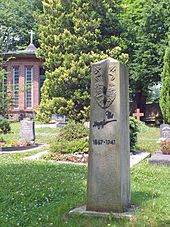Elsa Asenijeff

Elsa Asenijeff , actually Elsa Maria Packeny (born January 3, 1867 in Vienna , Austria , † April 5, 1941 in Bräunsdorf , Saxony ), was an Austrian writer and partner of Max Klinger .
Life
Elsa Maria Packeny came from the Viennese upper middle class. Her father Karl Packeny (1841–1889) was director of the Austrian Southern Railway , her mother was Laurenzia, née Adametz (1841–1932). Elsa had two younger sisters.
She attended the elementary and community school and then, until 1887, the Vienna Teacher Training Institute . After she turned down several marriage proposals, her father died and she was forced to get married. In 1890 she married the Bulgarian engineer and diplomat Ivan Johannis Nestoroff, who was eleven years her senior, and went to Sofia with him . The marriage was not a happy one. She felt at the mercy of her husband, a subject that shaped her literary works in many different ways. In 1896 her short story book Is that love? under the pseudonym Elsa Asenijeff, which she had chosen in memory of her deceased firstborn son Asen.
In 1896 she divorced Nestoroff. The Bulgarian state allowed her to use Asenijeff as her official name. 1897 she went to Leipzig to philosophy and economics to study. She left her second son Heraklit, born in 1896, with his grandparents.
At a celebratory dinner for Detlev von Liliencron (1844–1909) and Frank Wedekind (1864–1918) held by the Literary Society in Leipzig , she met the painter and sculptor Max Klinger (1857–1920). She became his model, muse and lover. Klinger did not make the love affair public. He paid her an expensive apartment in the elegant music district (270 m² in Schwägrichenstrasse 11, mezzanine floor ). She accompanied him on numerous trips and acted as a hostess at social events, including in his house. She was considered an extremely impressive, fascinating, and sometimes extravagant personality. During a lengthy stay of Asenijeff with Klinger in Paris , their daughter Désirée was born on September 7, 1900 († 1973 in Sydney , Australia ), who was given to a French foster mother.
In 1903 Klinger acquired a vineyard including a small winegrower's house in Großjena , which he expanded into a normal residential building in order to be able to withdraw from the hectic city life of Leipzig with Asenijeff. She wrote for the feature pages of various Leipzig newspapers. Further books of her appeared. From 1912 she also wrote poetry. Guests of her salon were among others the three young poets Walter Hasenclever (1890–1940), Kurt Pinthus (1886–1975) and Franz Werfel (1890–1945).
During this time, Klinger also created numerous depictions of his partner.
- Representations by Elsa Asenijeff
Photograph by Nicola Perscheid , 1897
An estrangement that developed between Klinger and Asenijeff deepened when Klinger chose 18-year-old Gertrud Bock (1893–1932) as a model and constant companion in 1911, and she married a few months before his death. In 1916 there was a final break between Asenijeff and Klinger.
This separation hit Elsa Asenijeff very hard, psychologically and materially, because Klinger refused to give her any further support. In 1917 she had to give up the apartment at Dufourstrasse 18, into which she had moved in 1909. Since then she has not appeared in Leipzig address books as the main tenant. She only lived in boarding houses. A descent into poverty began, combined with a certain decline in personality. Even a volume of poetry published in 1922 did not bring a turning point.
Elsa Asenijeff was completely isolated, had no connection to her Viennese relatives, and her daughter Désirée, who stayed for some time in Leipzig for the funeral of her father in 1920, did not get in touch with her. Rent debts and unruly behavior in connection with her self-neglect ultimately led to her being admitted to the psychiatric clinic of the University of Leipzig. She viewed her incapacitation as a fraud and demanded compensation because she still saw herself as one of the greatest writers. A two-year stay in the Leipzig-Dosen sanatorium was followed by the transfer to Hubertusburg in 1926 and finally to the Colditz supply house as "not dangerous to the public" . In 1933, the responsible authorities relocated this facility as a "correctional institution for asocial and unwilling adults" to Bräunsdorf near Freiberg .
From this time, by her dated 1938, comes a manuscript with over 200 poems with the title “Balance of Modernity”. According to the files, Elsa Asenijeff died in Bräunsdorf on April 5, 1941 of pneumonia.
Since 2011 there has been a stele erected by the Kulturhof eV Kleinvoigtsberg in the Bräunsdorfer Friedhof in memory of Elsa Asenijeff.
Create
Asenijeff deals in her books with topics such as violence in gender relations, the sexual oppression of women or the inability of men to treat women as equal partners on a spiritual level, and can be seen as an early forerunner of difference feminism . Some of her works have autobiographical traits. She also followed Klinger's artistic work with great interest, such as B. in the study of his Beethoven sculpture.
She is considered an early representative of Expressionism in literature.
Works (selection)
- Is that love? Small psychological stories and reflections. 2nd Edition. Friedrich, Leipzig 1896, (Reprint: Turmhut-Verlag, Mellrichstadt 2005, ISBN 3-936084-43-2 )
- Longing , Wilhelm Friedrich Verlag, Leipzig, 1898. ( digitized )
- Riots of Women and the Third Sex. . Wilhelm Friedrich Verlag, Leipzig, 1898. (Online at ALO ). (Reprint: Austrian literature online, Volume 7. Austrian literature online, Graz (among others) see a. , ISBN 3-226-00394-1 ).
- Nostalgia. . Wilhelm Friedrich Verlag, Leipzig 1898. (Online at ALO ).
- Innocence, a modern book of fairy tales , Verlag Hermann Seemann Nachhaben, Leipzig, 1901. ( digitized )
- Diary sheets of an emancipated person. . Seemann, Leipzig 1902. (Online at ALO ). (Annotated new edition: Turmhut-Verlag, Mellrichstadt 2006, ISBN 3-936084-61-0 ).
- Max Klinger's Beethoven - an art-technical study . Hermann Seemann successor, Leipzig 1902.
- The sisters, a novella , magazine publisher Jacques Hegner, Berlin and Leipzig, 1905. ( digitized )
- The new Scheherazade. A novel in feelings. . Müller, Munich 1913. (Online at ALO ).
- Song of Songs to the Unnamed , Georg Müller Verlag, Munich, 1914 (Reprint Nabu Press, 2012, ISBN 978-1-274-60794-2 ). ( digitized )
- Outcry. Free rhythms. AH Payne, Leipzig 1922.
- Balance of Modernity - Poems from the Institution , (Ed. Rita Jorek), Turmhut-Verlag, Mellrichstadt 2010, ISBN 978-3-936084-82-5 .
- Bo Osdrowski / Tom Riebe (eds.): Elsa Asenijeff. Versensporn - Booklet for lyrical charms No. 19, Edition POESIE SCHMECKT GUT, Jena 2015, 120 copies.
literature
- Rita Jorek: outcry (Elsa Asenijeff). In: Friderun Bodeit (Ed.): I have to be able to give myself completely. Women in Leipzig. Verlag für die Frau, Leipzig 1990, ISBN 3-7304-0256-0 , pp. 175–190.
- Peter Nürnberg: Crowned dream. Elsa Asenijeff as a writer. In: Leipziger Blätter issue 17/1990. (Seemann), Leipzig 1990, ISSN 0232-7244 , pp. 40-43.
- Horst Riedel: Stadtlexikon Leipzig from A to Z . PRO LEIPZIG, Leipzig 2005, ISBN 3-936508-03-8 , p. 27.
- Rita Jorek: Asenijeff, Elsa (1867–1941). In: Britta Jürgs (Ed.): Because there is nothing left as nature intended. Portraits of women artists and writers around 1900. AvivA , Berlin ( inter alia ) 2001, ISBN 3-932338-13-8 , pp. 53–72.
- Annegret Friedrich: Max Klinger and Elsa Asenijeff. Gender difference as a program. Dedicated to the memory of Ursula Baumgartl. In: Femme fatale. Drafts. Women - Art - Science, Volume 19. S. n. , Mannheim 1995, pp. 31-41, OBV .
- Elsa Asenijeff. In: Christa Gürtler, Sigrid Schmid-Bortenschlager: Stubbornness and Resistance. Writers of the Habsburg Monarchy . Ueberreuter, Vienna 1998, ISBN 3-8000-3706-8 , pp. 201-212.
- Brigitte Spreitzer: In the shine of his fame ... Elsa Asenijeff (1867–1941), in the twilight. In: Frauke Severit (Ed.): I was all of that. Politicians, artists, eccentrics of Viennese modernism. Böhlau, Vienna ( inter alia ) 1998, ISBN 3-205-98922-8 , pp. 163-201.
- Brigitte Spreitzer: 'Kotzbrocken'. Elsa Asenijeff's assertion of a feminine way of thinking against the “great delusion” of male science. In: Brigitte Spreitzer: Textures. Austrian modernism for women. Studies on Modernism, Volume 8, Passagen-Verlag, Vienna 1999, ISBN 3-85165-365-3 , pp. 131-134. (At the same time: Habilitation thesis, University of Graz, Graz 1998).
- Brigitte Spreitzer: “Don't always be this one me”… The “small chain of eternal decomposition processes” in the attempts at female self-constitution with Elsa Asenijeff. In: Spreitzer: Textures. Pp. 70-78.
Web links
- Biogram Elsa Asenijeff in the Leipzig Lexicon
- Elsa Asenijeff among women personalities, University of Leipzig
- Literature by and about Elsa Asenijeff in the catalog of the German National Library
Individual evidence
- ↑ a b c Rita Jorek: outcry. see ref.
- ^ A b c Christiane Kruse: Who lived where in Leipzig. Verlagshaus Würzburg - Stürtz, 2011, ISBN 978-3-8003-1997-8 , p. 8.
- ↑ Leipzig Lexicon
- ↑ a b Elsa Asenijeff (1868–1941). Nonconformist and artist muse. Biography . ( Memento from January 6, 2013 in the Internet Archive ) In: Frauen-Werke. Ariadne Project, Austrian National Library, 2006.
- ↑ SLUB Dresden Historic Addressbooks
- ↑ Peter Nürnberg: Dream crowned. Elsa Asenijeff as a writer.
| personal data | |
|---|---|
| SURNAME | Asenijeff, Elsa |
| ALTERNATIVE NAMES | Packeny, Elsa Maria |
| BRIEF DESCRIPTION | Austrian writer of early expressionism |
| DATE OF BIRTH | January 3, 1867 |
| PLACE OF BIRTH | Vienna |
| DATE OF DEATH | April 5, 1941 |
| Place of death | Bräunsdorf (Oberschöna) |











